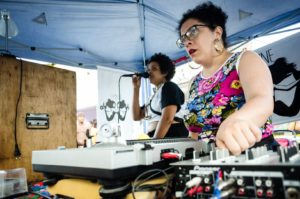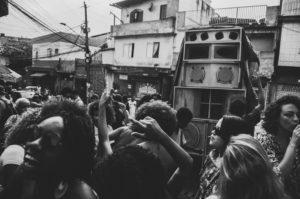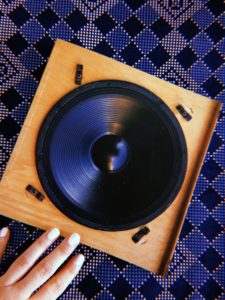Mapping the Brazilian Sound System Culture
Brazil can lay claim to possibly the richest and most diverse SST scenes and cultures anywhere in the world. Our projects plans to research this is depth and detail. So we are very pleased to publish this interview with Dani Pimenta, co-founder of the Feminine Hi-Fi collective as well as the Mapa Sound System Brazil website (link), as a first taste of what is to come. We’ve worked with Feminine Hi Fi last year as part of our online event SSO#7 (link) and we were truly impressed by their professionalism, energy and dedication. The SST project commitment towards capacity building made it a very natural choice to ask the Mapa team to contribute to the mapping of the global diaspora of the sonic street technologies.
This blog is also available in Portuguese at this link.
—
Could you please introduce yourself and the Mapa Sound System Brasil team?
Hi! I’m Dani Pimenta. I’m a journalist, music selectress, cultural producer and researcher. I am the co-founder of the Feminine Hi-Fi project and the founder and editor of the Brazilian reggae website “Groovin Mood”. I am also the creator of the Mapa Sound System Brasil project. This project turned into a book in 2019. I co-authored the book together with Natan Nascimento. He is a soundman, founder of Favela Sound System, a designer and a selector.
How and when did your passion for popular music and sonic street technologies start?
There has been a bond between me and music since I was a little girl. I grew up in the Centro of Sao Paulo, the biggest city in Latin America, and that means a lot of chaos LOL! I’ve been influenced by record and cassette stores around me since I was a child, and also by the music my family used to listen to. It was basically Afro-Brazilian music (sambareggae, samba, pagode and other sounds) and sertanejo raiz music.
Growing up, as a teenager I used to go to rap parties hosted in underground venues or on big dance floors in the late 1990s-early 2000s, in the famous bailes black that were taking over the city.
My interest in the dancefloor, the street, the night, the popular music and the urban sounds led me to find out about Java in 2006. Java is a party promoted by Dubversão sound system here in São Paulo. The first time I went to Java and got in touch with the sound system culture, it was like I was abducted. I never gave up on this passion; it continues to grow, year after year.

Feminine Hi Fi performing in Sao Paulo.
We know that Brazil is a kind of goldmine for sonic street technologies. Could you briefly give us an overview of the different SST that it is possible to find in the country?
The history of Brazilian SST inspired by Jamaican culture can be traced back to the 1970s in the State of Maranhão, also called the ‘Brazilian Jamaica’, with its traditional radiolas – which are huge walls of speakers, operated by large crews and with a special focus on reggae roots.
A little earlier, in the 1980s, another kind of SST, the sonoros paraenses / aparelhagems had a boom thanks to the growth and popularization of rhythms such as tecnobrega and tecnomelody, a local historical heritage.
In Brazil, we have other styles of sound system too, such as ‘funk walls’ (paredoes de funk), the trio electrico (very connected to our Carnival culture), and paredões automotivos: speakers placed in the trunk of a car, playing a variety of rhythms, such as piseiro or bregafunk.
In the early 2000s, on the other hand, another way to celebrate Jamaican culture came to Brazil, directly inspired by the European sound system scene. This has started a new wave for Brazilian sound systems experimenting with this trend – with pioneers in this style such as Dubversao, Digitaldubs and others.

Selector Dexter Campbell at a Jurassic sound system session, São Paulo 2014. Photo by Dió Vieira
So there are two main types of SST in Brazil devoted to Reggae music?
Yes, in Brazil we have two main ways of amplifying reggae music, which are radiolas and sound systems. I think both ways are directly inspired by Jamaican culture and by its “model” – and also by its evolution in Europe – as well by local Latin American adaptations. A bit of our own culture, mixed with the Caribbean culture that we admire and respect, and with local adaptations of the Latin culture.
The radiolas spread in the State of Maranhão during the 1980s and this led to a local explosion of reggae music both in the State and in its capital, the city of São Luís, earning them the well-deserved nickname Jamaica Brasileira. But the history of reggae in Maranhão truly begins in the 1970s. The most widespread narrative about how reggae came to Brazil is that sailors used to import vinyl records from Jamaica when they came to São Luís.
In the 1980s reggae was spreading around the city’s outskirts and started growing a fanbase; the city was on fire! Here, people deeply identify with roots reggae music. There is also a unique way of dancing, called reggae agarradinho, recently declared Intangible Cultural Heritage by UNESCO. The radiolas were getting bigger and spreading everywhere. This passion became a big business, an economic power capable of moving large professional crews, especially in Maranhão, but also in other areas of Brazil. Their huge walls of speakers are truly impressive.
Sound systems, on the other hand, started spreading around the country only in the early 2000s, more inspired by the European scene. The number of crews increased year by year and by the mid-2010s, this is when the scene blew up and grew exponentially. According to the data from the Reggae Museum, located in Maranhão, there are more than two hundred radiolas in activity today. Our first mapping raised more than 120 sound systems in 2019, but today that number is much higher.

Feminine Hi-Fi + Ruído Rosa Sound System in Heliópolis (São Paulo, Brazil, 2019). Photo by Milena Camilotti
Where does the idea of the Sound System Mapa Brazil come from, and what was its initial manifestation?
Almost two decades after the beginning of the local cultural and musical movement of the reggae sound systems, now widespread around the country, an initial survey of reggae sound systems was produced. Slightly later, in 2019, my friend Natan and I turned the survey data into a book: Mapa Sound System Brasil. Natan Nascimento is a graphic designer, selector, founder of the Favela Sound System, based in Jundiaí, a city located in the Metropolitan Area of São Paulo. The book contains illustrations from over 120 sound systems.
The book is the final result of the online project Mapa Sound System Brasil. I started this project in 2015 on my own Groovin Mood blog, a blog devoted to reggae music which I have been running since 2008. In the beginning, the idea was to gather the reggae sound systems active on the national territory on a map. In 2018 Nathan and I got together and created the publication / book / catalogue. It also includes interviews to local and international artists such as Walshy Fire and Mad Professor. We received some funds from the City Hall of São Paulo – Secretariat of Culture for the production of the book.
The book does not pretend to be a definitive guide to the Brazilian sound system scene; this culture is moving constantly and growing more and more. As authors, we wanted to obtain a sample – as accurate as possible – of what was happening in Brazil at that time. Our aim was to give an overview of the reggae sound system cultural movement in Brazil.
The number of existing reggae sound systems in the country is much higher than the total reported in the book – which is nothing more than a shoot of a given moment – and it keeps on growing, week by week. It’s huge… And we’re just scratching the surface.
And now the book has turned into a website!

Mapa Sound System Do Brasil (2019), book cover
You mentioned that the book received funds from the São Paulo City Hall, and that’s great. More generally, in your opinion what is the reception of SST and popular urban culture in the wider cultural context?
The manifestations of popular and street culture are very strong in Brazil, despite the precariousness of public policies related to them. A clear example of this is funk, a very popular cultural form which is constantly under attack by the most conservative sections of society. Funk has resisted and it is still strongly resisting, and reaching places in the music market that previously seemed unreachable. It is interesting how Brazilian sonic street technologies and cultures spread in off-street environments, even now, under this gloomy government.
There are some world-famous rap groups, such as Racionais MCs, that are studied in academic or more formal environments. Also, the sound systems are currently reaching places that seemed unreachable before, such as big stages, festivals, renowned libraries, cultural institutes, regular clubs… I think barriers are being broken down step by step, but I also think we have suffered a very important setback after the victory of Bolsonaro and the rising of far-right sympathizers here. Right now, street culture is very dynamic in Brazil, and that could lead us to a better outlook, depending on the next elections result.
Can you illustrate a bit the Mapa Sound System Brasil website?
The website expands and builds on the previous work done for the blog and the book, and it aims to record and preserve the memory of the Brazilian reggae sound system culture, and how its uniqueness and richness impact on local cultures all over the country.
The website was launched in September 2021, and we are still tweaking some features. The idea is that everybody can tell their own story. There is an open form for registering crews and also for single artists, selectors and selectresses, and other professional figures. At the moment there’s also a section to consult articles, interviews, and other readings, and an area to browse registered users. It will soon have what we call ‘Reggae Analytics’, which are data collected from different forms, such as ethnicity, age group and location, among others. The idea is to update this data every semester.

Radiolas in Maranhão. Photo by Dani Pimenta
How do you think the website can support the culture in Brazil? And what has been the feedback from within the scene?
The Brazilian sound system culture has no documentation at all, although radiolas have been studied over decades. The Mapa website is an initial step towards documenting and preserving local sound system culture memories. I think this amazing culture has given us a lot, especially in the last few years, and I think this is our way of giving back.
Recently, another book specifically focused on the sound system paulistano was published here in São Paulo, which is Sob Frequência (‘Sub-Frequency’), by photographers Miguel Salvatore and Melissa Sirks. The book is an amazing photographic compilation; it contains historical records of 19 different photographers. We believe that both the Mapa and Sob Frequência can inspire other people’s work, so that we can preserve and share this history.
As a selectress for Feminine Hi Fi you have toured Europe twice: what is your impression of the sound system scene here compared to Brazil (or São Paulo)?
Yes, Feminine Hi Fi toured Europe twice, but personally I was only able to travel once (on the second trip I was recovering from had a surgery). The European sound system scene impressed me because of the level of professionalism. As you may reckon, of course there is a gap between the so-called ‘first’ and ‘third’ world, we know it, but that thing really impressed and inspired me.
Another wonderful thing is the crowd’s commitment. People are always present and excited, and they’re staying until the end helping to clean up the place. All this brought me positive vibes, and made me think about what we can do to make the scene progress here, even with all the social and economic setbacks we’re facing right now.

Feminine Hi-Fi in Heliópolis, Laylah Arruda on the mic (São Paulo, Brazil, 2019). Photo by Milena Camilotti
What have you personally learned by running the Mapa project, from Groovin Mood through the book and now the website?
I’ve been learning and I’m still learning a lot every day. I learned about how the huge size of our country produces different ways of making a sound system work, about how much people love what they do despite the difficulties, and I learned that everything we do, we do for something much bigger than ourself. The passion that moves the sound system culture, the resistance, the Jamaican heritage spreading around the whole world and taking strong roots here in Brazil – as testified by the size of our scene – is something very powerful, very transformative.
What are the future plans for the Mapa Sound System project?
We want to improve the platform, so that it gets way easier to access, to get registration, and we also really want to reach those who are not exactly connected to the internet but we cannot leave out, such as builders, radioleros, singers… Digital mapping alone may not reach these people, so we have been thinking a lot about how to overcome this impasse and acknowledge these people’s precious work. And keep on working, always!
—
Dani Pimenta is a journalist, cultural producer, selectress and music researcher. She is the founder and editor of Groovin Mood, a website dedicated to the reggae and sound system scene in Brazil, and co-author of the project Mapa Sound System Brasil. Co-founder of Feminine Hi-Fi project, and ambassador member of the WME (Women´s Music Event) Awards, the first Brazilian award dedicated to women in the music industry.
–
Translated from Portuguese by Alice Izzo.
